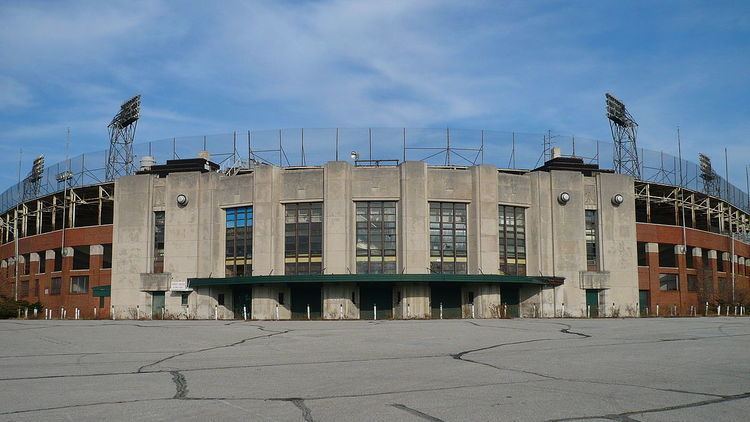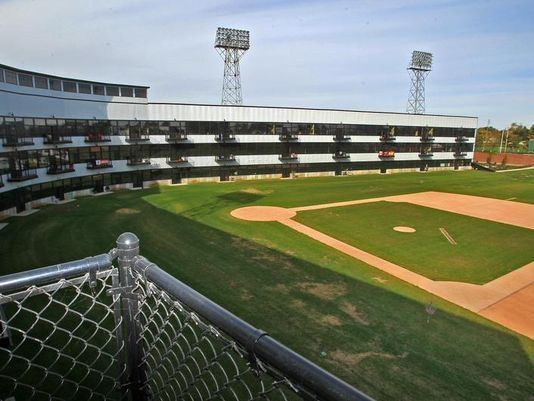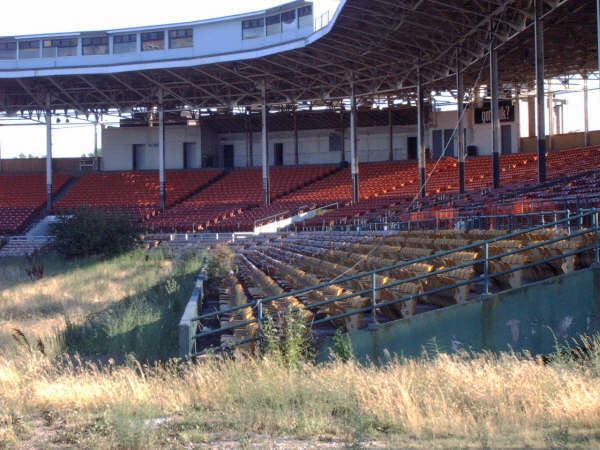Full name Owen J. Bush Stadium Area 6 ha | Opened 5 September 1931 Architectural style Art Deco Added to NRHP 26 June 1995 | |
 | ||
Location 1501 West 16th StreetIndianapolis, IN 46202 Capacity 15,000 (1931–1937)13,000 (1938–1946)13,254 (1947–1979)12,934 (1980–1996) Field size Left Field – 335 ft (102 m)Left Center Field – 350 ft (110 m)Deep Left Center – 405 ft (123 m)Center Field Inner Fence – 395 ft (120 m)Deep Right Center – 405 ft (123 m)Right Center Field – 350 ft (110 m)Right Field – 335 ft (102 m) Similar Esplanade Apartments, The Blacherne, Delaware Court, George Stumpf House | ||
Abandoned bush stadium indianapolis
Owen J. Bush Stadium is the name of a former baseball stadium in Indianapolis, Indiana. It was home to the Indianapolis Indians from 1931 to 1996. It was also home to a few Negro League teams, as well as a Continental Football League team, the Indianapolis Capitols, who won the league championship in 1969.
Contents

Early History

The stadium started life as Perry Stadium, named for club owner Norm Perry, who built it in 1931. Construction was completed by Osborn Engineering, who also constructed Fenway Park. The Indians played their first game in the ballpark on September 5, 1931. It was renamed Victory Field in 1942 in reference to World War II. In 1967 the ballpark was sold to the city of Indianapolis, who leased it back to the Indians. Later that same year it was renamed for former major league baseball player and Indianapolis native Donie Bush, who had served as president of the Indians from 1955 to 1969.

English ivy was planted on the brick outfield walls of Perry Stadium prior to its opening. P.K. Wrigley liked the appearance of the ivy, and subsequently instructed the iconic Wrigley Field ivy in Chicago to be planted. The ivy in Indianapolis remained after the stadium became Victory Field and then Bush Stadium, but was discontinued in 1996, when the Indians moved to the current Victory Field ballpark downtown.

During the 1930s, Perry Stadium was home to many Negro League teams. These included the ABCs (1932, 1938, and 1939), American Giants (1933), Athletics (1937) and Crawfords (1940). Later, it would be home to the Indianapolis Clowns, a barnstorming team that was well known for "comical antics". The Clowns won the Negro American League championship in 1952, with the help of Hank Aaron. They played in Indianapolis from 1944 to 1962. Later, the Clowns featured Toni Stone, the first female Negro League player in history. Even after the Indianapolis Indians integrated in 1952, the Clowns continued to play at then-Victory Field.
In 1987, Bush Stadium was dressed up in different ways to be used as the stand-in for both Comiskey Park and Crosley Field during the filming of Eight Men Out, which was about the "Black Sox Scandal", the throwing of the 1919 World Series. It was vacated by the ballclub when they moved to the new downtown ballpark Victory Field in mid-season 1996. The official site states that the older Victory Field was given that name "celebrating the United States’ victory in World War II". Since the name was first used in 1942, it would originally have been intended to encourage victory (as with the famous victory gardens).
Indianapolis hosted the Pan Am Games in 1987 and the baseball events were held at Bush Stadium.

In 1997, Tony George, president of the nearby Indianapolis Motor Speedway, leased the property and converted it into a dirt track named the 16th Street Speedway for midget car auto racing. The ivy was removed from the outfield walls around this time. As happened with a similar venture involving Philadelphia's Baker Bowl several decades earlier, the auto racing venture failed (after two years). The property closed and the stadium fell into disrepair, with no apparent future. The Indy Parks Department had control of the land, which was zoned as a park. At the time, it was estimated that renovations, which would include removal of asbestos and lead paint, could cost around $10 million.
Between 2008 and 2011 the Stadium was used as a storage site for cars traded in as part of the Cash for Clunkers program.
In 2011 it was proposed the stadium be turned into an apartment complex, and on March 15, 2012 demolition began on portions of the 81-year-old structure. The 138 loft units were completely leased when the complex opened on July 27, 2013. The dirt portion of the infield has now been paved with stamped red concrete, but the lights that lit up the field at night still stand. Much of the exterior facade has been preserved, and many of the historic features, such as the owner's suite and the ticket booth, have been incorporated into the loft apartments. There are studio, one, and two bedroom units in the complex. The cost of the project was $13 million, of which the city funded $5 million. The Stadium Lofts complex includes both the loft apartments within the former stadium building and newly constructed flats.
Dimensions
Original
Later
Final
